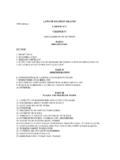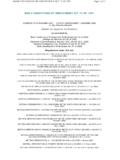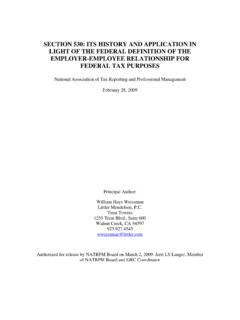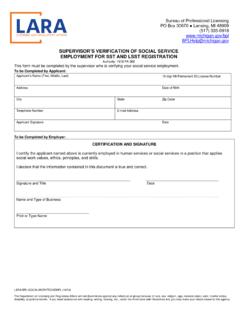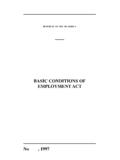Transcription of worker classification pamphlet - irs.gov
1 PRESENT LAW AND BACKGROUND RELATING TO worker classification FOR FEDERAL TAX PURPOSES Scheduled for a Public Hearing before the SUBCOMMITTEE ON SELECT REVENUE MEASURES and the SUBCOMMITTEE ON INCOME SECURITY AND FAMILY SUPPORT of the HOUSE COMMITTEE ON WAYS AND MEANS on May 8, 2007 Prepared by the Staff of the JOINT COMMITTEE ON TAXATION May 7, 2007 JCX-26-07 i CONTENTS Page INTRODUCTION .. 1 I. worker classification RULES .. 2 A. Present 2 B. Reasons for Misclassification of Workers .. 8 II. EFFECT OF MISCLASSIFICATION ON FEDERAL 10 III.
2 ALTERNATIVE METHODS OF CLASSIFYING 12 A. General Issues .. 12 B. Issues Under Specific Proposals .. 14 1 INTRODUCTION The Subcommittee on Income Security and Family Support and the Subcommittee on Select Revenue Measures of the House Committee on Ways and Means have scheduled a joint public hearing for Tuesday, May 8, 2007, on the effects of misclassifying workers as independent contractors. This document,1 prepared by the staff of the Joint Committee on Taxation, provides a description of present law and background relating to worker classification for Federal tax purposes.
3 1 This document may be cited as follows: Joint Committee on Taxation, Present Law and Background Relating to worker classification for Federal Tax Purposes (JCX-26-07), May 7, 2007. This publication is also available on the web at 2 I. worker classification RULES A. Present Law In general Significant tax consequences result from the classification of a worker as an employee or independent contractor. These consequences relate to withholding and employment tax requirements, as well as the ability to exclude certain types of compensation from income or take tax deductions for certain expenses.
4 Some consequences favor employee status, while others favor independent contractor status. For example, an employee may exclude from gross income employer-provided benefits such as pension, health, and group-term life insurance benefits. On the other hand, an independent contractor can establish his or her own pension plan and deduct contributions to the plan. An independent contractor also has greater ability to deduct work-related expenses. Under present law, the determination of whether a worker is an employee or an independent contractor is generally made under a facts and circumstances test that seeks to determine whether the worker is subject to the control of the service recipient, not only as to the nature of the work performed, but the circumstances under which it is performed.
5 Under a special safe harbor rule (sec. 530 of the Revenue Act of 1978), a service recipient may treat a worker as an independent contractor for employment tax purposes even though the worker is in fact an employee if the service recipient has a reasonable basis for treating the worker as an independent contractor and certain other requirements are met. In some cases, the treatment of a worker as an employee or independent contractor is specified by statute. Significant tax consequences also result if a worker was misclassified and is subsequently reclassified, , as a result of an audit.
6 For the service recipient, such consequences may include liability for withholding taxes for a number of years, interest and penalties, and potential disqualification of employee benefit plans. For the worker , such consequences may include liability for self-employment taxes and denial of certain business-related deductions. Common-law test In general, the determination of whether an employer-employee relationship exists for Federal tax purposes is made under a common-law test that has been incorporated into specific provisions of the Internal Revenue Code (the Code ) or that is required to be used pursuant to Treasury regulations or case law.
7 For example, section 3121(d)(2)2 (which defines terms for purposes of the Social Security taxes that apply to wages paid to an employee) generally defines the term employee to include any individual who, under the usual common law rules applicable in determining the employer-employee relationship, has the status of an employee. By contrast, section 3401 (which defines terms for purposes of an employer s Federal income tax withholding obligation with respect to wages paid to an employee) does not define the term employee. However, regulations issued under section 3401 incorporate the common-law test.
8 2 Except as otherwise indicated, all references to sections are to sections of the Code. 3 The regulations provide that an employer-employee relationship generally exists if the person contracting for services has the right to control not only the result of the services, but also the means by which that result is accomplished. In other words, an employer-employee relationship generally exists if the person providing the services is subject to the will and control of the employer not only as to what shall be done but how it shall be done.
9 3 Under the regulations, it is not necessary that the employer actually control the manner in which the services are performed, rather it is sufficient that the employer have a right to Whether the requisite control exists is determined based on all the relevant facts and circumstances. Over the years courts have identified on a case-by-case basis various facts or factors that are relevant in determining whether an employer-employee relationship exists. In 1987, based on an examination of cases and rulings, the Internal Revenue Service ( IRS ) developed a list of 20 factors that may be examined in determining whether an employer-employee relationship The degree of importance of each factor varies depending on the occupation and the factual context in which the services are performed; factors other than the listed 20 factors may also be relevant.
10 The 20 factors identified by the IRS are as follows: 1. Instructions: If the person for whom the services are performed has the right to require compliance with instructions, this indicates employee status. 2. Training: worker training ( , by requiring attendance at training sessions) indicates that the person for whom services are performed wants the services performed in a particular manner (which indicates employee status). 3. Integration: Integration of the worker s services into the business operations of the person for whom services are performed is an indication of employee status.











